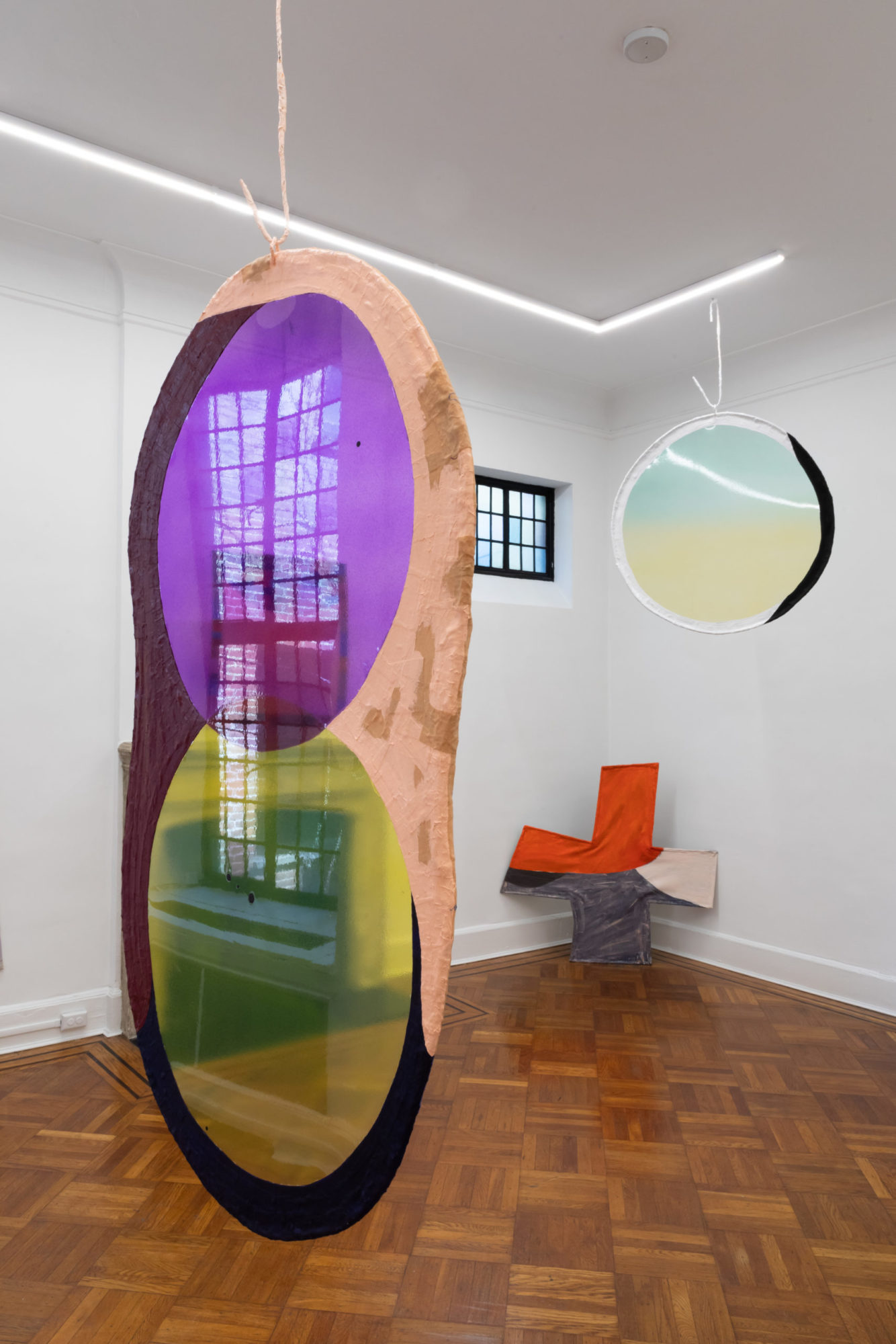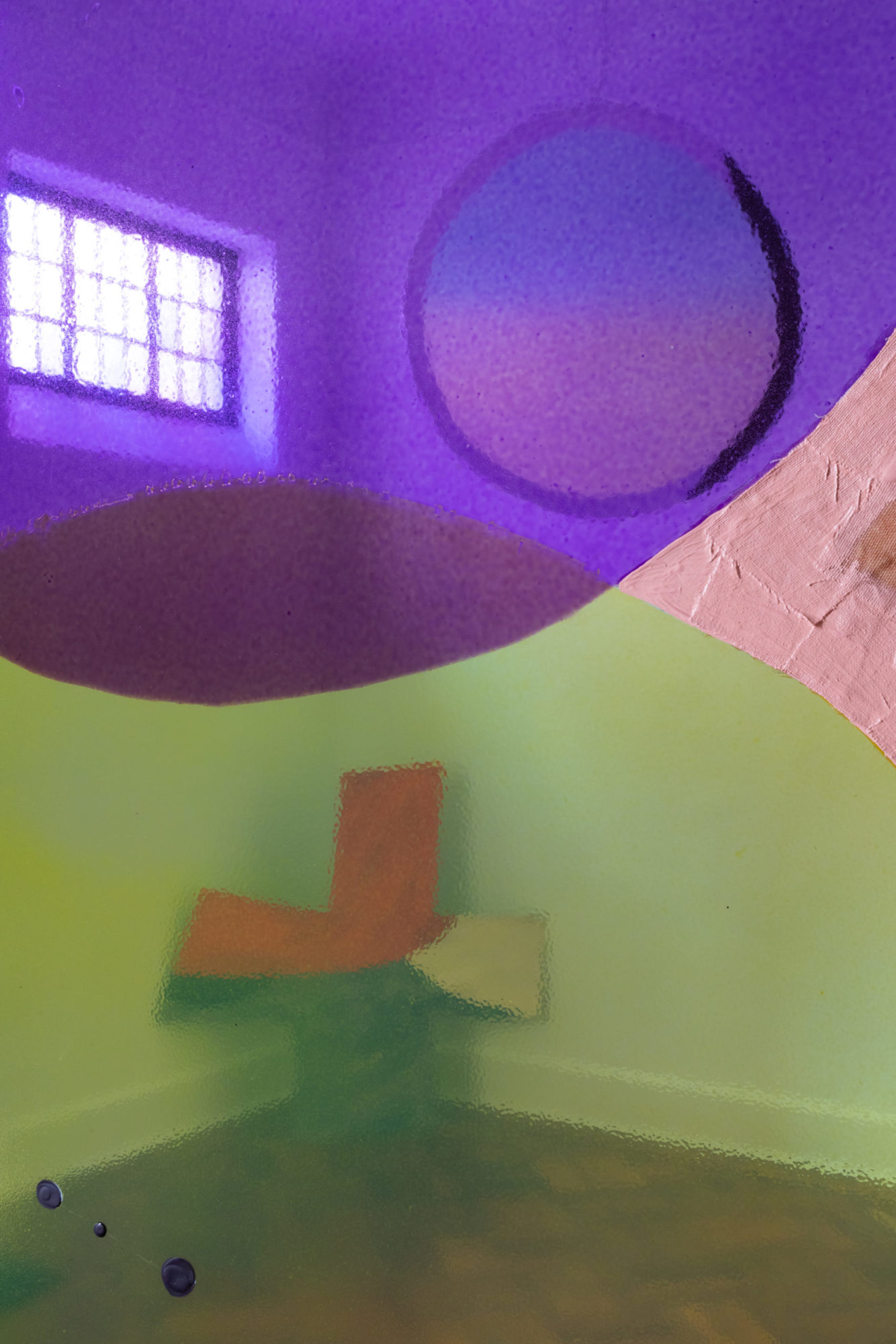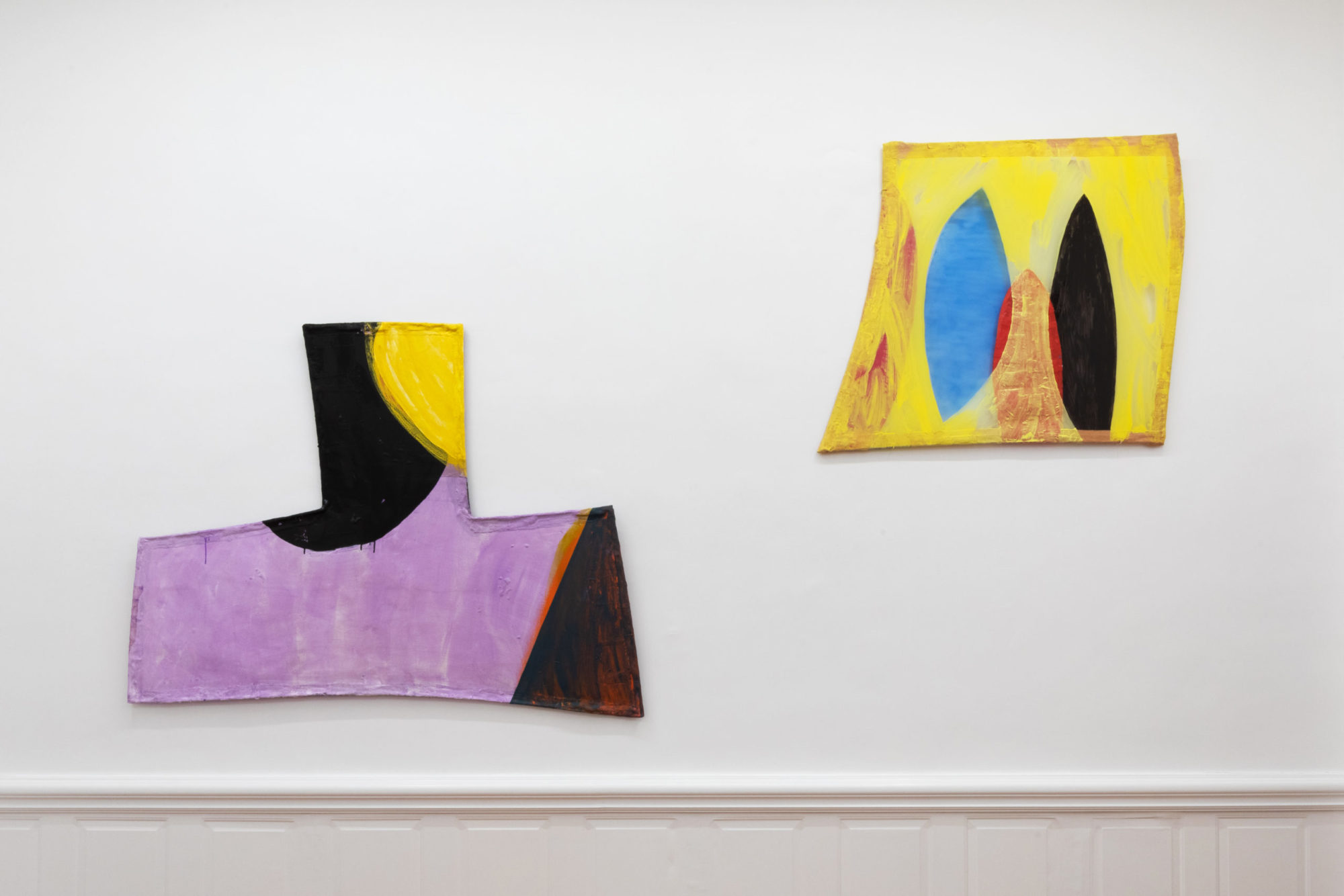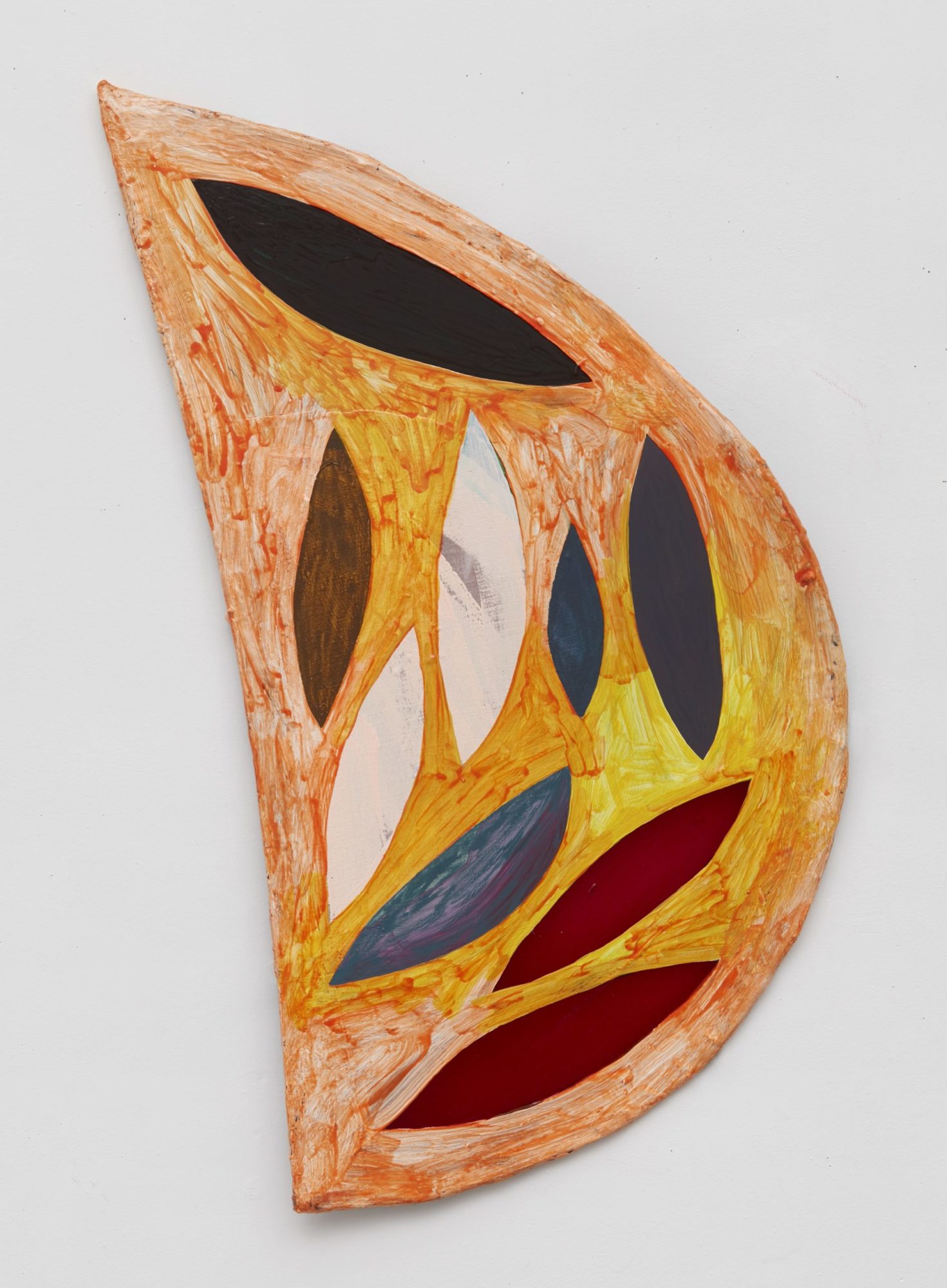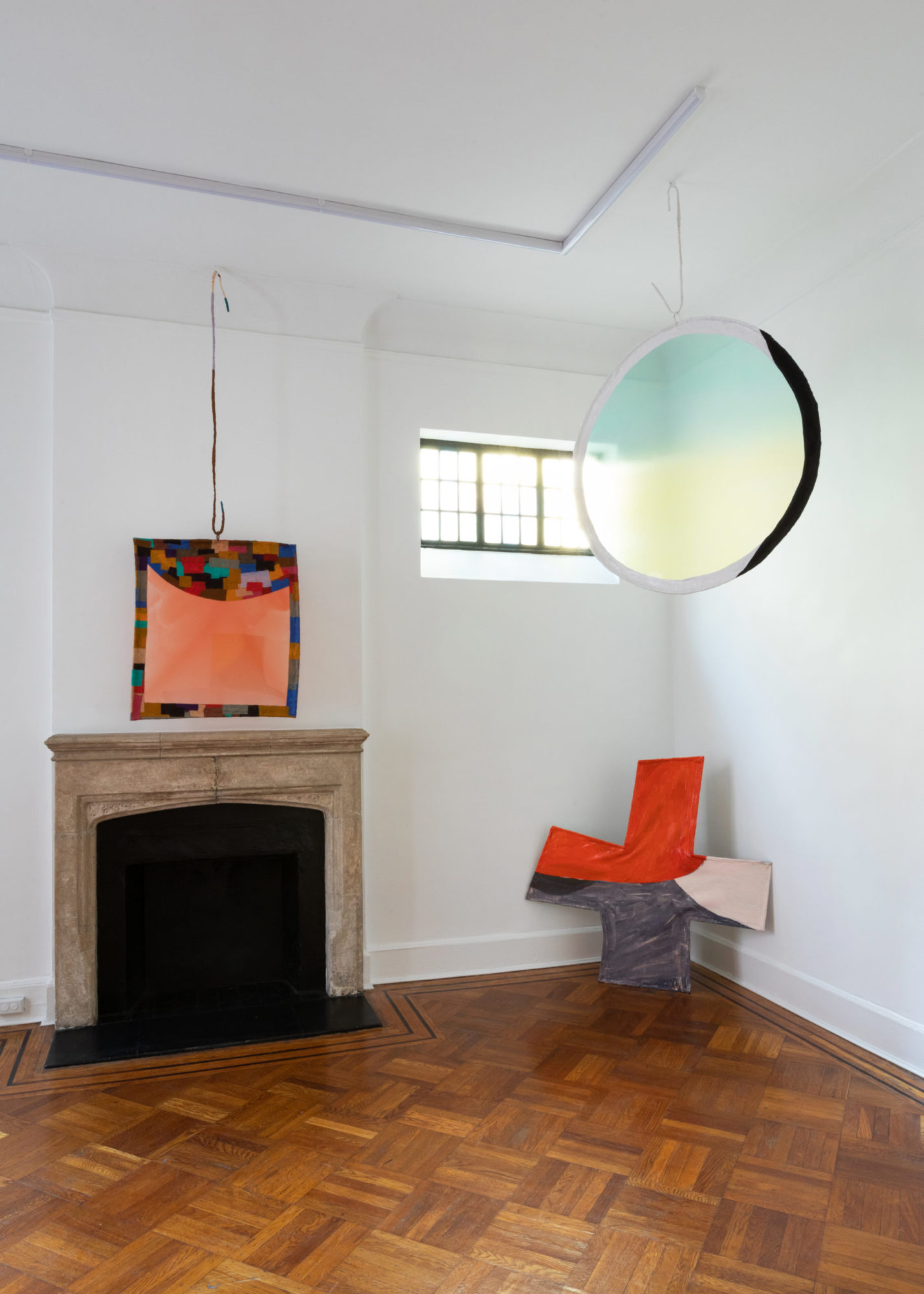Fabienne Lasserre: Eye Contact
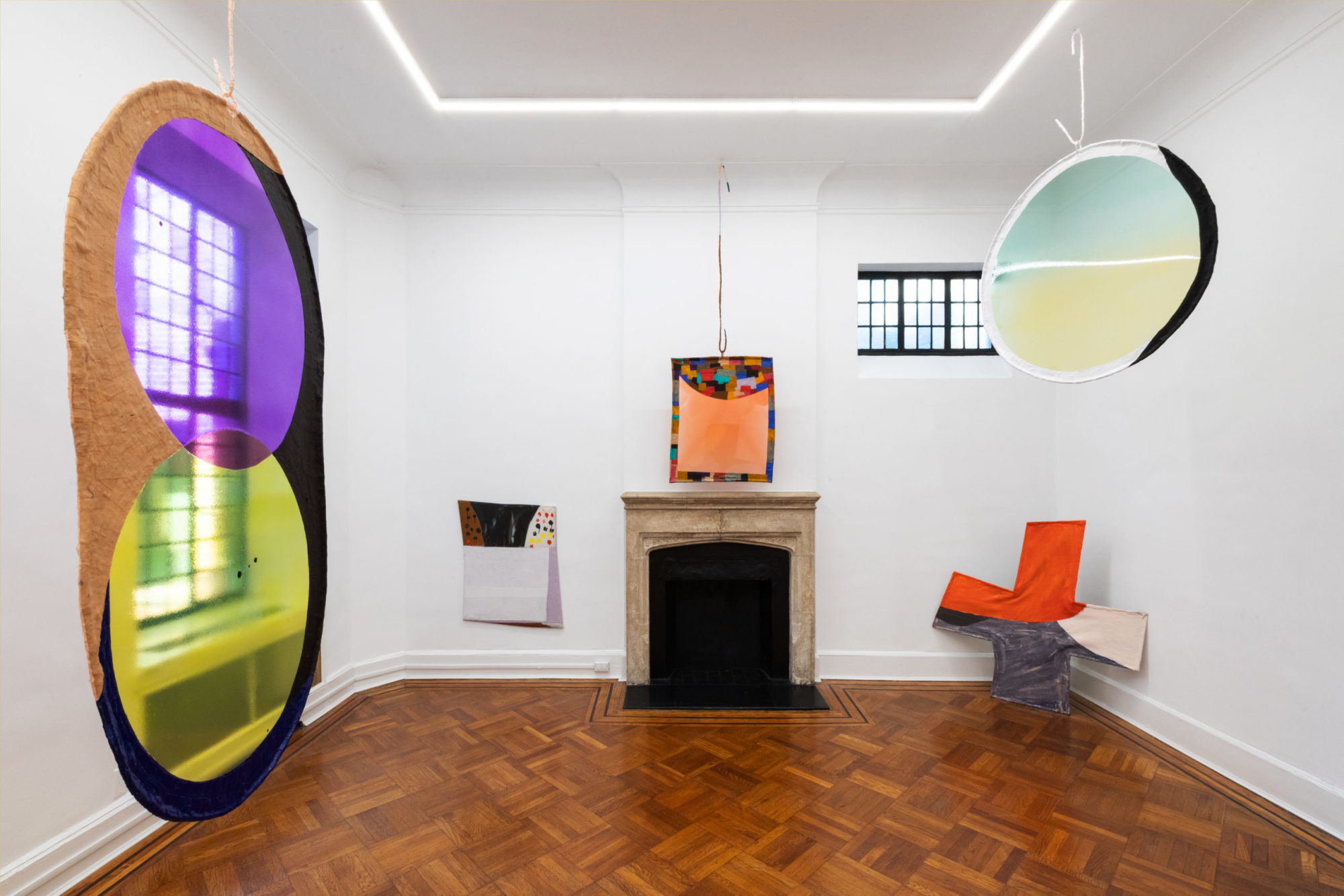
Fabienne Lasserre, Eye Contact (installation view), 2021 [courtesy of TURN Gallery, New York]
Share:
Paintings have always talked to walls—what’s on, built into, attached to, hung from, and tucked away inside them; how they continually frame, curate, hold, and design our bodies’ activities—but Fabienne Lasserre’s exhibition Eye Contact, at TURN Gallery’s new, Upper East Side location, does even more. These works don’t attempt to erase the space with what they depict, or how. Rather, they absorb it, conversing with architectural niceties, nosing around the edifice’s many attributes, making something akin to an expanded transcript of the visible world in the moment.
Walking into TURN, I felt as if I were in the presence of oversized amulets, mobiles, experimental lenses, and geometrically offbeat objects quietly skewing the space and repositioning my body within the gallery. Some works dangle from the ceiling. Another, on the floor, leans in a corner, against two walls. Several hang on walls, but far above or below the expected viewing height. Just the act of looking at, and around, the room shifts—the eye zigzags up, then down again, following an undulating choreography. Add to this ambulatory act of surveying that not one straight edge exists in any piece: the works’ bent edges tinker with the almost perfectly cubic room.
Fabienne Lasserre, Eye Contact (installation view), 2021 [courtesy of TURN Gallery, New York]
Fabienne Lasserre, Eye Contact (installation view), 2021 [courtesy of TURN Gallery, New York]
All of Lasserre’s works here read like sculptural objects, perhaps as much—or even more—than as paintings, but the three that descend from the ceiling do so most of all. It’s as if this trio—Appear, Eye-touch, and Between Notes (all 2020)—were props to be used inside the gallery, things not just to be looked at but through. Each hangs at a different height: one high and pendulum-like; another, peanut shell–shaped, meets viewers in the middle of the gallery; the third, a huge pendant, hovers above the mantle of an old fireplace. These works are separated from others in the show by their lenslike qualities. Sprayed or poured acrylic tints sheets of stretched, clear vinyl, which are then framed by textured swatches of colorful linen, creating something akin to an oversized color gel. Although only one of these works hangs at a height where a viewer could actually look through the lush surface, these semi-transparent shapes—circles and a near-parallelogram—nevertheless act as vehicles for conducting light and activating the space for viewers.
Glancing around this room is maybe what it would be like inside some quiet kaleidoscope of colored bits. I kept walking around Eye-touch, using the purple and yellow disks as ocular devices through which to view the rest of the work and the room, simultaneously getting distracted by all the creamy lemons, mustards, peachy tints, and lilacs that reappeared throughout the exhibition. Looking up at Appear, I noticed the gallery’s thin, fluorescent lights reflecting on its colored surface, bending into a wobbly cursive script. As still as the exhibition is, it begs us to keep moving, keep twisting, tilting, and peering.
Fabienne Lasserre, Eye Contact (installation view), 2021 [courtesy of TURN Gallery, New York]
It’s hard to believe these items weren’t made especially for TURN’s new location. An uncanny color rhyme occurs among Eye-touch, Appear, and two permanent stained-glass windows in the gallery space. Lavender panes in the largest window near Eye-touch couldn’t be closer in color to the purple in the work’s upper half, and its complementary yellow orb almost matches the lighter yellow segments in the window. On the other wall, the glass in the window behind Appear just about perfectly pairs with the gradient Lasserre has fashioned—a slow color fade moving from pale blue to light buttery yellow. What’s perhaps most interesting about the rhyming in these works is how they receive the room.
Inside Lasserre’s exhibition, I always feel like I’m looking at the work, and at the room, and at a room created by the work. Hymn and Hum sit irregularly on the wall, opposite Between the Notes, Hum much higher than Hymn. In the shape of a sort of upside-down, truncated uppercase T, Hymn rests just a few inches above a flawlessly level line of trim running along the wall. No one side of this work is parallel to another. The object’s nonconforming edges in such proximity to this interior design detail make the wall seem to vibrate. Then there’s Hum, on high, with its own uneven sides near the crown molding. These juxtapositions engineer quiet perceptual shifts in the way one experiences the room’s rectilinear elements—walls and flooring, but also molding, trim, neatly concealed channels of electrical wiring, and even the wall’s surface characteristics. All this interaction between things changes the spatial rhythm of the chamber.
Fabienne Lasserre, Orange Moon, 2020, linen, steel, acrylic polymer, urethane paint, transparent vinyl, 38 x 22 x 1 inches [courtesy of TURN Gallery, New York]
Fabienne Lasserre, Eye Contact (installation view), 2021 [courtesy of TURN Gallery, New York]
A potent activation of texture, form, and color in Lasserre’s work tunes in to the discourse between seeing, being, acting, and built space. I think a lot of this animating force has to do with the artist’s hand, which Lasserre never hides: the making of the thing always peeks through. Seams stand out. Loose strands of linen linger. The surface patchwork of glued-together fabric in Between Notes bubbles a bit. Although the lush, prismatic, plasticlike sections in the trio of dangling works have a much slicker finish than their rough framing elements, they eschew the laser-cut look of Adobe-friendly vector designs, and this quality reinforces Lasserre’s vernacular shorthand. The resulting texture-verse makes me think about Alan Shields, Hélio Oiticica, Rosy Keyser, Mike Cloud, French Supports/Surfaces painters, and others for whom visible craft and construction are key to relating art to physical bodies, and to communal space. The work, as the title of Lasserre’s show suggests, asserts “eye contact” as a form of empowerment. The politics of looking informs a politics of touch.
Paintings have much to discuss with the basic blueprints of an average apartment, home, or office space—especially in 2021, as many of us have been unexpectedly boxed into domestic dwellings for more than a year. They also have a dialogue with the many viewing interfaces inside such spaces—televisions, touch screens, social media filters, Zoom backgrounds, etc.—that will continue, for years to come, to redefine how we see. I’ve recently seen many paintings that un-self-consciously disappear into a muffled design scheme which recalls wallpaper from the American 1960s or 70s; and others that haphazardly fade into the digital mud of stock backgrounds and gaming landscapes. Dialogue with such realms can be productive—I think of Ruth Root’s work, in which there’s an intersection of pattern and modular prefab home products—but part of painting’s sorcery is its ability to concoct a prepositional zone to our lived reality: beyond, because of, amongst, without, minus, toward, via, prior to; the list goes on. Lasserre’s objects cultivate these zones, inviting us to embody—and dwell in—them.
Anthony Hawley is a New York-based interdisciplinary artist and writer. His short films and solo exhibitions have been presented by Vox Populi, CounterCurrent festival with the Menil Collection and Aurora Picture Show, the Guggenheim Museum’s Works & Process series, and others. His writing on art and film appears regularly in Frieze, The Brooklyn Rail, Hyperallergic, Artforum, BOMB, Carla, art-agenda, and elsewhere. Hawley and violinist Rebecca Fischer form the multidisciplinary collaboration The Afield. He is the author of two poetry collections, and his artist book dear donald … is forthcoming from NoRoutine Books.
